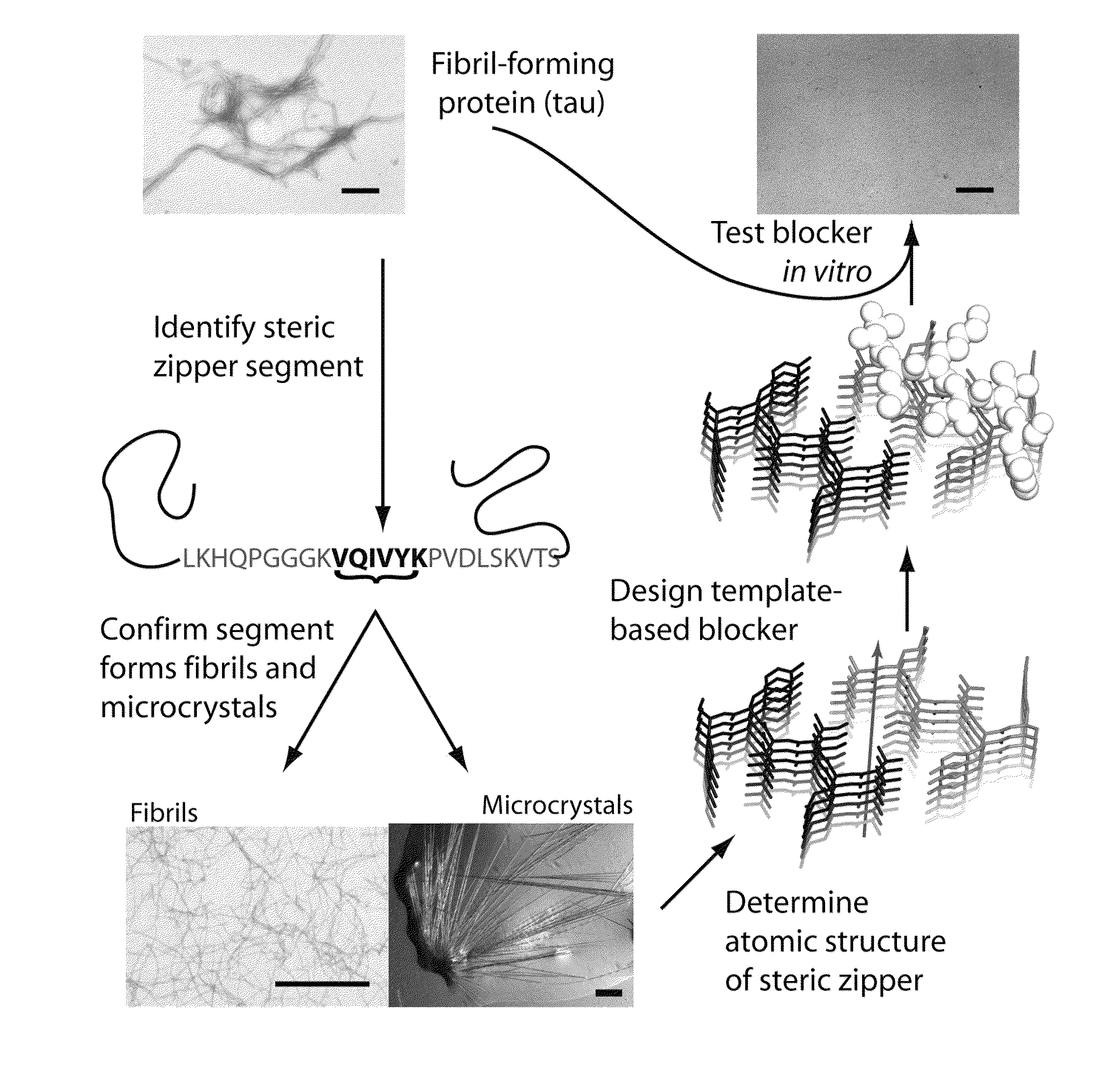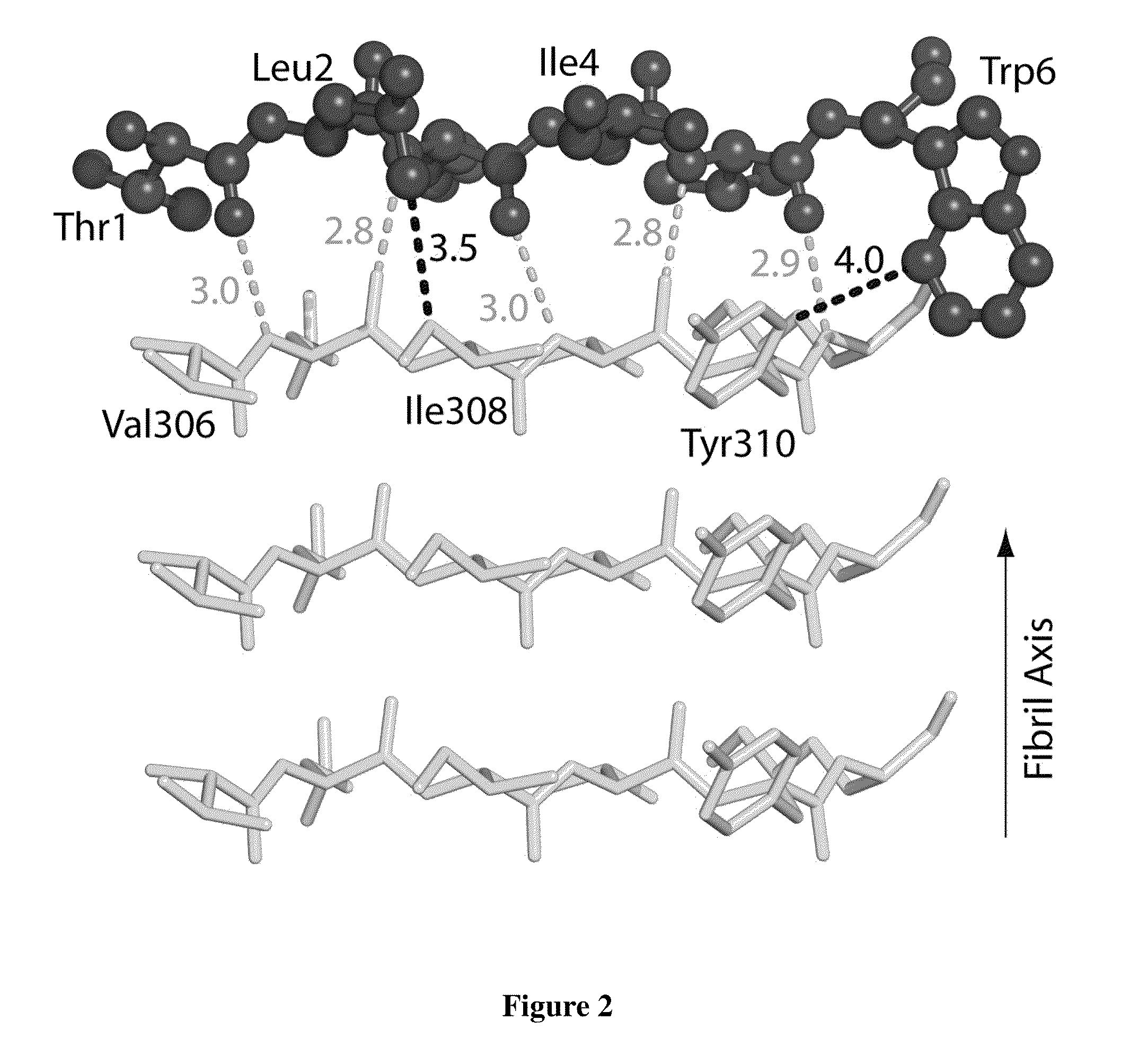Structure-based design of peptide inhibitors of amyloid fibrillation
a technology of amyloid fibrillation and inhibitors, which is applied in the direction of peptide/protein ingredients, peptide sources, instruments, etc., can solve the problems of difficult structure-based design of amyloid fibrillation inhibitors, inapplicability of misfolding approaches, and ineffective empirical approaches
- Summary
- Abstract
- Description
- Claims
- Application Information
AI Technical Summary
Benefits of technology
Problems solved by technology
Method used
Image
Examples
example 1
Structure-Based Design of D-Amino Acid Peptide Inhibitors of Tau Fibrillation
[0095]To design D-amino acid peptides that disrupt fibril formation, a procedure was adopted that is analogous to mirror image phage display techniques. D-amino acid peptides were designed that can cap the end of the known structure of the VQIVYK steric zipper (M. R. Sawaya et al., Nature 447, 453 (May 24, 2007)). These peptides can inhibit the fibril formation of the tau protein. The methods involve reversing the stereochemistry of the steric zipper structure (which is built from L-amino acids) to create a virtual D-amino acid structure of the steric zipper. Because of the polarity of the fibril axis found in the steric zipper structure, we designed peptide caps for both the top and bottom of the steric zipper. The RosettaDesign algorithm was used to build a set of L-rotamers and selected those that would favorably interact with the D-amino acid steric zipper (B. Kuhlman et al., Science 302, 1364 (Nov. 21,...
example 2
Inhibition of K12 Fibrillation with D-Amino Acid Peptide Inhibitors
[0096]The following describes the experimental methods used to evaluate the inhibitory effects of the D-peptides described above.
[0097]Materials and Methods
[0098]All peptides were purchased from CS Bio Co. Peptides were dissolved at 0.5 mM in 250 mM phosphate buffer immediately before fibril inhibition assays. ThS was obtained from MP Biomedicals, Inc. Heparin (average MW of 18000) was obtained from Sigma.
[0099]K12 Expression and Purifications
[0100]The expression vector pNG2, a derivative of pET-3b (Studier et al., 1990), containing the K12 gene, was generously provided by E. Mandelkow (Biernat et al., 1992). We used the BL21 (DE3) E. coli for expression (Studier et al., 1990). K12 was purified based on previously described methods (Barghorn et al., 2005). In short, the cell pellet was resuspended in 20 mM MES pH 6.8, 1 mM EDTA, 0.2 mM MgCl2, 5 mM DTT, 1 mM PMSF, and a protease inhibitor cocktail. The cells were soni...
PUM
| Property | Measurement | Unit |
|---|---|---|
| molar ratio | aaaaa | aaaaa |
| molar ratio | aaaaa | aaaaa |
| pH | aaaaa | aaaaa |
Abstract
Description
Claims
Application Information
 Login to View More
Login to View More - R&D
- Intellectual Property
- Life Sciences
- Materials
- Tech Scout
- Unparalleled Data Quality
- Higher Quality Content
- 60% Fewer Hallucinations
Browse by: Latest US Patents, China's latest patents, Technical Efficacy Thesaurus, Application Domain, Technology Topic, Popular Technical Reports.
© 2025 PatSnap. All rights reserved.Legal|Privacy policy|Modern Slavery Act Transparency Statement|Sitemap|About US| Contact US: help@patsnap.com



